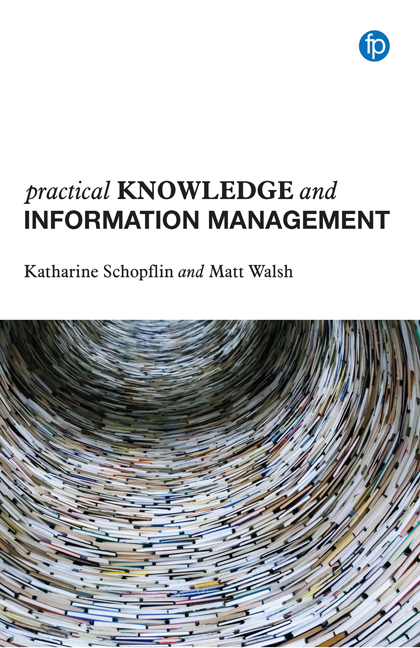Book contents
- Frontmatter
- Contents
- Case studies and sidebars
- 1 Introduction to knowledge and information management
- 2 Introducing knowledge and information management to organizations
- 3 Information management and governance
- 4 Communities and knowledge-sharing
- 5 Making knowledge explicit: knowledge bases, know-how and wikis
- 6 Capturing knowledge legacy: passing on staff knowledge
- Afterword: the future of knowledge and information management
- References
- Index
3 - Information management and governance
Published online by Cambridge University Press: 01 June 2019
- Frontmatter
- Contents
- Case studies and sidebars
- 1 Introduction to knowledge and information management
- 2 Introducing knowledge and information management to organizations
- 3 Information management and governance
- 4 Communities and knowledge-sharing
- 5 Making knowledge explicit: knowledge bases, know-how and wikis
- 6 Capturing knowledge legacy: passing on staff knowledge
- Afterword: the future of knowledge and information management
- References
- Index
Summary
Every organization needs to keep track of the content it has created. Yet most organizations’ information assets are stored in multiple locations with little corporate control over what is kept where, and for how long. Even where one or two appropriately structured central systems cover key functions (for example, customer relationship management in sales, stock control in retail, or case management in law), it is likely that staff have access to and use many other data repositories in the course of their work. And the number of places where staff might store the information they create is only increasing. This chapter is about the issues KIM professionals need to consider when managing expressed knowledge: where it can be found, what risks it carries, and what you can do about them. In an increasingly chaotic world of written information, what can an information manager do to provide structure?
The key issue for workers who create or require information comes under the headings ‘findability’ and ‘putability’. This is covered by the questions ‘Can I find the information I need to do my job?’ and ‘Where do I put the information I have created?’ The answer to both questions should be the same, so that staff can access information created by each other. In our post-manufacturing world, most organizations’ largest output is collections of words and numbers held in Word documents, Excel spreadsheets and PowerPoint presentations. Where they end up depends on how the issues of findability and putability are addressed. This is the essential task of the information manager and one that has only increased with the quantity of explicit information. One of the authors of this book once overheard a senior policy-maker complain that their e-mail inbox was full of essential policy, strategy and position papers that she needed to read, but she was too busy writing other such papers to do so. Over time, not just the quantity but the number of locations of recorded corporate information has increased. And as more items are saved in shared repositories, the more difficult it is to find useful content and ensure it is kept for the right amount of time.
- Type
- Chapter
- Information
- Practical Knowledge and Information Management , pp. 25 - 52Publisher: FacetPrint publication year: 2018

